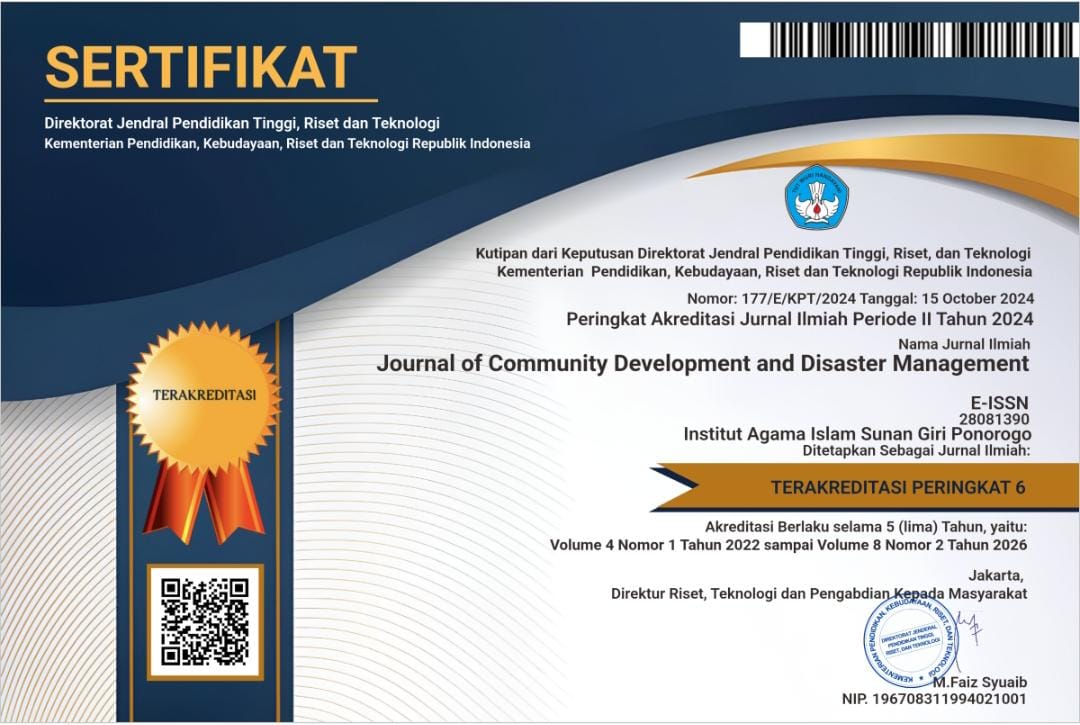The Role of Twitter Sentiment Analysis for Disaster Resilience in a World Class Destination: A Case Study of Ubud, Bali
DOI:
https://doi.org/10.37680/jcd.v7i2.8421Keywords:
Sentiment Analysis, Natural Language Processing, Twitter, Ubud, Disaster Resilience, TourismAbstract
Accurate, real-time information is crucial for Disaster Resilience efforts, making it essential for prominent international tourist destinations in Bali, such as Ubud, which are vulnerable to hydro-meteorological hazards. This study aims to explore public response patterns to the landslide and flood disaster in Ubud via Twitter (X) data, interpreting the resulting sentiment as a real-time social indicator for crisis management. The methodology adopts the CRISP-DM framework, utilizing a Natural Language Processing (NLP) approach—specifically lexicon-based sentiment analysis and visualization—on Indonesian-language tweet data with the keywords ubud banjir (Ubud flood) and prayforbali following the disaster in October 2022. Key findings reveal an absolute dominance of positive polarity (reaching 98.8%) in public opinion. This significantly high positive sentiment is interpreted as a digital manifestation of strong Social Capital and a collective priority to safeguard Ubud's destination image during the recovery phase, which contrasts with sentiment patterns observed in non-tourism disaster contexts. This analysis contributes to Disaster Informatics by positioning public sentiment as a Real-time Social Indicator. A recommendation that local governments leverage this sentiment data as a strategic asset to enhance crisis communication transparency and reinforce Ubud’s image as a resilient and safe international destination.
References
Ariyanti, N. M. P., & Ardhana, I. K. (2020). Dampak psikologis kekerasan dalam rumah tangga terhadap perempuan pada budaya patriarki di Bali. Jurnal Kajian Bali, 10(01), 283–304.
Borges, J. T., Gatti, M., & Silva, D. E. A. (2024). CRISP-NET: Integration of the CRISP-DM Model with Network Analysis. MDPI.
Chandra, D. N., Indrawan, G., & Sukajaya, I. N. (2016). Klasifikasi berita lokal Radar Malang menggunakan metode Naïve Bayes dengan fitur N-Gram. Jurnal Ilmiah Teknologi dan Informasia ASIA (JITIKA), 10(1).
Dufty, N. (2012). Using social media to build community disaster resilience. Australian Journal of Emergency Management, 27(1), 20–25.
Hermawan, L., & Ismiati, M. B. (2020). Pembelajaran text preprocessing berbasis simulator untuk mata kuliah information retrieval. Jurnal Transformatika, 17(2), 188–199.
Hossain, M. S., & Rahman, M. F. (2022). Detection of potential customers’ empathy behavior towards customers’ reviews. Journal of Retailing and Consumer Services, 65, 102875.
Hossain, M. S., Rahman, M. F., Uddin, M. K., & Hossain, M. K. (2022). Customer sentiment analysis and prediction of halal restaurants using machine learning approaches. Journal of Islamic Marketing, 13(7), 1361–1385.
Miller, J. D. (2017). Big Data Visualization. Packt Publishing.
Putra, I. N. D. (2007). Wanita Bali tempo doeloe. Pustaka Larasan.
Rahayudi, F. F. (2021). Analisis sentimen pada Twitter bencana alam di Kalimantan Selatan menggunakan metode Naïve Bayes. Jurnal Pengembangan Teknologi Informasi dan Ilmu Komputer (J-PTIIK), 5(12), 5614–5621.
Rahjasa, S. L., Wiranata, I. G. A., & Mahardika, I. G. E. D. (2024). How travel influencer and social media influence tourist travel decision to Ubud. TRJ (Tourism Research Journal), 8(1), 127–127. https://doi.org/10.30647/trj.v8i1.243
Resnyansky, L. (2018). Social media data in the disaster context. Prometheus (United Kingdom), 36(1), 37–52.
Rochmaniyah, D. C., Aini, N. N., & Aprilia, N. S. (2023). Pemanfaatan media sosial Twitter oleh BNBP dalam upaya mitigasi bencana. Prosiding Seminar Nasional, 267–278.
Rofiyanti, E., & Hidayat, M. A. (2023). Analisis peran media sosial sebagai platform komunikasi dan penyebaran informasi kebencanaan di DKI Jakarta. Transparansi : Jurnal Ilmiah Ilmu Administrasi, 6(2), 192–201.
Shimaoka, J., Ferreira, J. D. C., & Goldman, A. R. (2024). The evolution of CRISP-DM for data science: Methods, processes and frameworks.
White, C. M. (2012). Social media, crisis communication, and emergency management: Leveraging Web2.0 technology. CRC Press.
Wirawan, P. E., Ardika, I. W., Anom, I. P., & Sudiarta, I. N. (2022). Potential of cultural heritage and local wisdom as a spiritual tourist attraction: Case studi in Caro Tegallalang Village Gianyar Bali. In Proceedings of INHEIC. https://inheic.com
Wirawan, P. E., & Rosalina, P. D. (2024). Enhancing cultural heritage tourism through a spiritual knowledge: The implementation of Tri Hita Karana in Taro Village Gianyar Bali. Journal Of Bali Studies, 14(1), 215–33.
WIRAWAN, P. E., WIDHIARINI, N. M. A. N., SUDIARTA, I. N., YANI, N. W. M. S. A., & NURUDDIN, N. (2023). The portrait of wellness tourism during the COVID-19 pandemic in Indonesia. A case study of health protocol implementation at Green Kubu Café Bali. Journal of Environmental Management and Tourism, 14(8), 3062. https://doi.org/10.14505/jemt.v14.8(72).07
Yuan, F., & Lin, M. (2021). Social media for enhanced understanding of disaster resilience during Hurricane Florence. International Journal of Information Management, 57, 102316.
Yuliana, I. (2019). Adopsi social network analysis (SNA) dalam upaya membangun ketangguhan bencana di masyarakat. Jurnal Informatika dan Komputer, 4(2), 49–54.
Yusuf, M., & Praptika, I. P. G. E. (2023). Development of Bali Spirit Festival to support sustainable spiritual tourism. International Journal of Religious Tourism and Pilgrimage, 11(6), 118–31.
Zhao, G., Xu, H., Fazhen, Z., Lufang, F., Yao, L., & Yuting, Z. (2024). How does social capital facilitate community disaster resilience? A systematic review. Frontiers in Environmental Science, 12. https://doi.org/10.3389/fenvs.2024.1496813
Zou, L., & Smaragdakis, N. (2018). Mining Twitter data for improved understanding of disaster resilience. Annals of the American Association of Geographers, 108(5), 1422–1441.
Downloads
Published
How to Cite
Issue
Section
License
Copyright (c) 2025 Imama Lavi Insani, Ni Luh Gede Pivin Suwirmayanti

This work is licensed under a Creative Commons Attribution-ShareAlike 4.0 International License.
JCD: Journal of Community Development and Disaster Management rekomendasi pencipta untuk memegang hak cipta tanpa batasan dan batasan pencipta untuk memiliki hak publikasi tanpa batasan, juga pemilik hak komersial atas artikel tersebut adalah pencipta.










